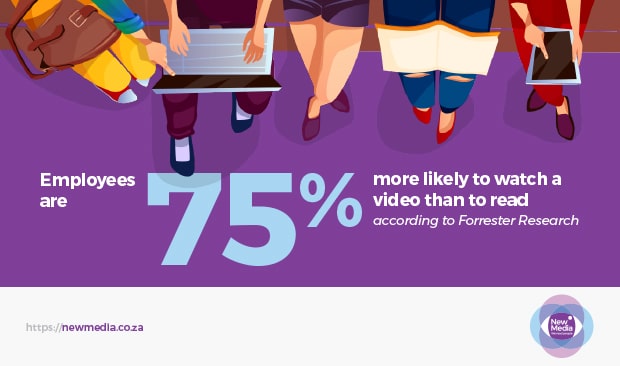Lead from in front … of the camera

Video is an important tool for leaders to build an emotional connection with their people. Here’s an introductory guide to harnessing the power of visual media for engaging your workplace.
Effective internal communication clues everyone in a company into the big picture and what it means for them. This leads to engaged employees and, ultimately, a more productive workplace.
But in this too-much-information age, reaching our colleagues is becoming more of a challenge than ever. That’s why, to cut through the clutter of documents, articles and emails, leaders must embrace digital video.
Video killed the written word
According to Forrester Research, employees are 75% more likely to watch a video than to read. And it’s great for information retention too – the brain absorbs 50% more through moving pictures and sound than the next best medium. So, filming your messages to your colleagues is really a no-brainer.

Lights, camera, action
But isn’t video hard, time-consuming and expensive? It can be daunting to get started, for sure, but the more often you film, the quicker it becomes second nature. Remember, you’re not aiming for Kubrickian levels of crafted storytelling – rather, you want to get a simple message across succinctly. Consider the following tips for talking-head* content.
(*Nope, not the amazing new wave band from the 80s; “talking head” refers to the type of video where someone talks directly to the camera, giving the effect of addressing the viewer personally. But speaking of the Talking Heads, you most definitely don’t want your messages to your colleagues to look like this.)
1. Be prepared
Know how your camera – or smartphone – works and invest in a lapel mic. Dress appropriately, sit upright and relax. Ensure the lighting is good and set the camera up to film in landscape.

2. Be strategic
It might sound obvious but your messaging should align with your business goals. That way, you’ll always know what you’re going to say and what you want your colleagues to do with that information.
3. Be yourself
Who are you at home? Try to express that on camera. Think of your audience as one viewer. Speak to that person the same way you’d speak to a relative in conversation.
4. Be buoyant
Stay energetic, watch your body language and make sure your voice is dynamic. You should always be positive but not overly excited – unless the situation calls for it.
5. Be consistent
As a leader, you’ll always have plenty of talking points. Consider a content schedule based on topics related to your strategy. But be agile and ready to respond to unexpected news.

In summary, if you’re confident about your business strategy, you should have no problem translating it for viewers. But where should your masterpiece live? Video in email is sketchy. One option is to host on an enterprise social network such as Workplace, but it really all depends on your company’s channel mix.
Our team has vast experience producing clips – from simple but effective talking-head content to more bells-and-whistles motion graphics – for several of our clients. The results are always well received and well worth the investment, so incorporating video into your internal communications strategy is something we highly recommend.
And that’s a wrap! If you’re keen to put video to work in your organisation, chat to our team of internal comms specialists, who’ll work with you to craft a video content strategy and plan that’s right for your business.

